 The next pattern in the Norns series is Verðandi. For this you will need one skein of Marks & Kattens Fame trend (single ply, 460 yds/420 m in a 100g skein). A few other yarns to consider might be Zauberball, Kauni or Sappho II. Other sock yarns in solid or semi-solid colours would also work.
The next pattern in the Norns series is Verðandi. For this you will need one skein of Marks & Kattens Fame trend (single ply, 460 yds/420 m in a 100g skein). A few other yarns to consider might be Zauberball, Kauni or Sappho II. Other sock yarns in solid or semi-solid colours would also work.
Colour-choices are up to you. My yarn has a lot of green (and some black/gray and golden-green) in it, and that works very well with the theme. The three norns live in a remote area of Aasgard, under the first root of Yggdrasil. They live in a dark cave, and in front of the cave is a well. The root of Yggdrasil snakes around the well. Each day the sisters collect water from the well and mix it with the magic clay and the coarse sand surrounding the well. They create a paste with which they cover the root to prevent rot and to preserve the life force of the tree.
Yggdrasil is the world tree – central to the nine worlds of Norse mythology. The tree has three roots that spread far and wide, to keep the trunk and the branches of the tree upright. The first root goes into Aasgard, where the gods live. The second goes to Jotunheim – home of the giants. And the third goes to Nifelheim.
As always, remember though that when you choose your yarn, you should pick something that *you* like. I have loved seeing all the different interpretations of Skuld – from the dark and unknown future I was envisioning, to misty gray, or the future seen through rose-coloured glasses, and the hopeful green.
The Verðandi pattern will be available on July 15.
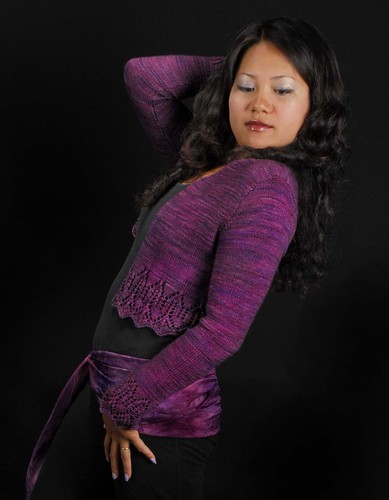 The Sanguine Gryphon released their 2010 summer line of patterns today, and I’m excited to announce that one of them is mine. This is the Cayuga Cardigan that I knit earlier in the spring.
The Sanguine Gryphon released their 2010 summer line of patterns today, and I’m excited to announce that one of them is mine. This is the Cayuga Cardigan that I knit earlier in the spring.
The Cayuga Cardigan is a half-length lacy cardigan, featuring a cathedral lace edging along the bottom edge and on the sleeve cuffs.
The cathedral lace motif is reminiscent of the clock tower at Cornell University. It lies on the top of a great hill overlooking Cayuga Lake.
The cardigan in the picture is size 38″, but the pattern is available in a wide range of sizes, from 34″-50″. It’s knit in Skinny Bugga! (450 yds/4 oz skein – merino/cashmere/nylon). My size used 2 skeins of yarn, but the larger sizes use a little more. I just loved knitting this cardigan with a hand-dyed semi-solid yarn. The colour variation in the stockinette portion kept my interest while knitting, and yet it doesn’t detract from the lace pattern at all.
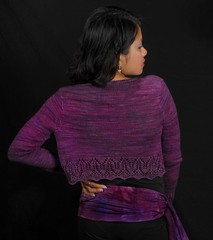

 The first shawl in the Norn series is Skuld. Skuld is one of the three Norns (Urðr, Verðandi and Skuld) in Norse mythology. The Norns spin the threads of life and death. The shawl show the intertwined threads of all living things.
The first shawl in the Norn series is Skuld. Skuld is one of the three Norns (Urðr, Verðandi and Skuld) in Norse mythology. The Norns spin the threads of life and death. The shawl show the intertwined threads of all living things.
The yarn used is dark blue and black, representing the dark and unknown future, since Skuld is the Norn representing that which should happen. It’s Sappho II from the Sanguine Gryphon in “Sleep Comes Down”. It’s also a single-ply yarn, like the yarn I imagine that the Norns spin for the threads of life.
At this point, the pattern is only available as part of the Seasons of Lace subscription.
Skuld in her natural environment in amongst the trees.
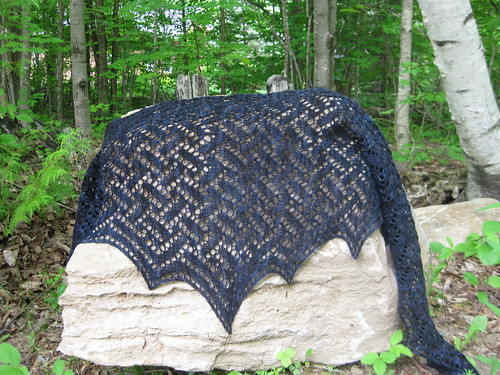
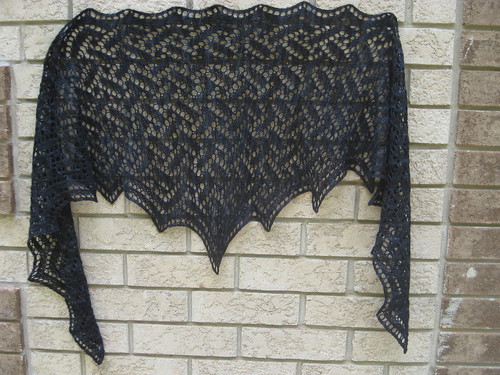
My favourite part of this shawl are the two endpoints. I really like how the edging continues along the top and the bottom V and meet in a point on the sides.
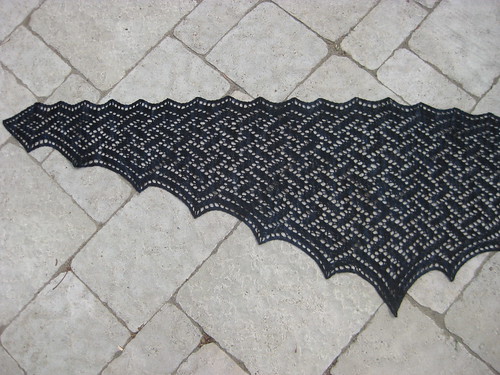
I’ve always liked math. And when it comes to math, geometry is particularly fun. All these fancy shapes and angles and lines that do or don’t intersect. I’m not certain that everyone shares my passion (actually, I’m certain that lots of people don’t), but the amazing thing with math is that there is a nice, neat solution to…. well…. everything. This interest in math has definitely carried over into my knitting.
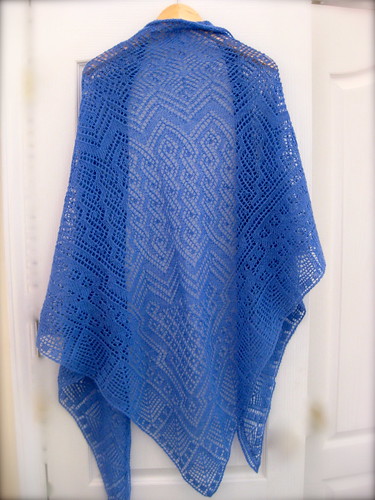
When I first decided to design a triangular lace shawl, I thought about how one might construct a triangle. The first and most obvious solution came to mind – start at the bottom point and make the rows longer as you go. And thus Mystic Waters was born.
The inverse construction is of course also possible – I could have started at the top edge, cast on lots and lots of stitches and made each row shorter until I reached the point where I couldn’t decrease any further. The main draw-back in my mind of that method is that I really don’t like casting on lots and lots of stitches and counting them, and recounting them to be sure I have the right number. Sometimes it is of course a necessary exercise, but it’s so much simpler to start with two stitches. Or four. Or five. Or something more manageable than fourhundredandtwentyseven.
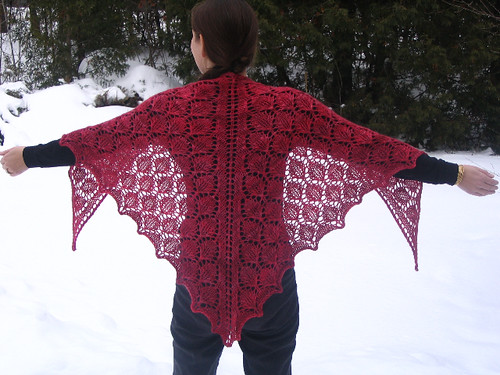 Once I had created Mystic Waters though, I noticed that there are a lot of triangular shawls that are made out of TWO triangles. So then it was time for another experiment, which resulted in the Sumac Leaf Shawl. This shawl is constructed from two triangles starting at the nape of the neck and growing outwards so that the longest edge of each triangle forms the bottom edge of the shawl. This construction is easily recognizable, because there is a well defined “spine” of the shawl. It’s quite common, and can be seen in shawls like Icarus, Ishbel and Swallowtail. The advantage of this type of construction over the bottom-up triangle used for Mystic Waters is that the shawl drapes quite nicely over your shoulders. The fabric stretches in a different direction, and pulls evenly towards the bottom edges of the shawl. And once again you start with relatively few stitches.
Once I had created Mystic Waters though, I noticed that there are a lot of triangular shawls that are made out of TWO triangles. So then it was time for another experiment, which resulted in the Sumac Leaf Shawl. This shawl is constructed from two triangles starting at the nape of the neck and growing outwards so that the longest edge of each triangle forms the bottom edge of the shawl. This construction is easily recognizable, because there is a well defined “spine” of the shawl. It’s quite common, and can be seen in shawls like Icarus, Ishbel and Swallowtail. The advantage of this type of construction over the bottom-up triangle used for Mystic Waters is that the shawl drapes quite nicely over your shoulders. The fabric stretches in a different direction, and pulls evenly towards the bottom edges of the shawl. And once again you start with relatively few stitches.
It is also possible to do the inverse construction of this type of shawl, by casting on even more stitches to cover the entire bottom V of the shawl and then work towards the neck. The Miralda Triangular shawl by Nancy Bush is an example of that construction. But again, the fact that I can’t face the idea of casting on fourhundredandtwentyseven-times-two stitches has kept me from designing a shawl using this inverse construction.
These are just a few ways to construct triangles. There are several others as well, but those are probably the most common when it comes to shawls.
Almost all of my patterns have been a result of me experimenting with shapes and constructions. I do enjoy playing with different combinations of shapes. They all have their advantages and disadvantages, which are fun to figure out while knitting. And the one thing that I can promise all the participants of the Seasons of Lace, is that each and every shawl for the next six months will be constructed differently. The very first shawl, Skuld, is a triangle shawl constructed in a manner not used for any of my previous shawls. I hope you enjoy it.
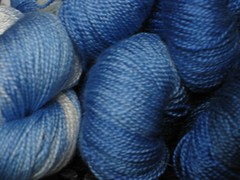 This is what is on my needles right now. I just received a shipment of Ling from Laura at the Unique Sheep. It’s part of their new Gradience collection, which in this case means that I received six 1-oz skeins in various shades of blue. The colourway is Illulissat, and ranges from a dark blue to a very light blue mixed with white. The skeins are numbered, and I chose to start at the dark end of the scale (#6) and work outwards towards the light. The yarn is lovely, really. I can’t show you any pictures of the actual shawl that is on my needles, since it’s part of the Norn series. The design was completed some time ago, but I was waiting for the perfect yarn, and here it is. So now my needles are burning as I’m working my way through the pattern.
This is what is on my needles right now. I just received a shipment of Ling from Laura at the Unique Sheep. It’s part of their new Gradience collection, which in this case means that I received six 1-oz skeins in various shades of blue. The colourway is Illulissat, and ranges from a dark blue to a very light blue mixed with white. The skeins are numbered, and I chose to start at the dark end of the scale (#6) and work outwards towards the light. The yarn is lovely, really. I can’t show you any pictures of the actual shawl that is on my needles, since it’s part of the Norn series. The design was completed some time ago, but I was waiting for the perfect yarn, and here it is. So now my needles are burning as I’m working my way through the pattern.
From what I understand, the Unique Sheep offers three different laceweight yarns – Ling (merino/silk), Eos (merino/tussah silk) and Ostara (cotton) which all knit up to the same gauge. I’ve worked with Eos before, and both Eos and Ling are quite nice, but of course the drape and the feel of the fabric is different.
I don’t know about you, but it seems to me that I often have multiple projects on the go in the same colour. So let me introduce you to my second current project……
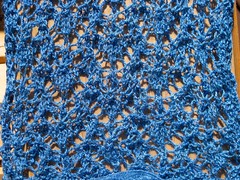 This is a lace scarf using some brand new yarn from FibroFibers. In fact, it is so brand new that it is not even available yet. Jen will be offering some Tussah lace-weight yarn, and sent me a sample. The colour is a cornflower blue (no idea what it will actually be called), and it is gorgeous. I couldn’t wait to cast-on, and I’m using the sample for a small lace scarf. The tussah silk has a small “halo” to it, and the halo combined with the sky blue colour made me think of angels. So here is a small section of my scarf with little angels spreading their wings.
This is a lace scarf using some brand new yarn from FibroFibers. In fact, it is so brand new that it is not even available yet. Jen will be offering some Tussah lace-weight yarn, and sent me a sample. The colour is a cornflower blue (no idea what it will actually be called), and it is gorgeous. I couldn’t wait to cast-on, and I’m using the sample for a small lace scarf. The tussah silk has a small “halo” to it, and the halo combined with the sky blue colour made me think of angels. So here is a small section of my scarf with little angels spreading their wings.
 And just so you don’t think I’m blind to all colours but blue, here’s the yarn for the third thing I’m working on. This is Nightfall from FibroFibers. It’s a fingering weight 100% merino, and this particular skein is in Ivy. The yarn changes colour from Ivy to black. The plan is to start from the dark centre of the skein and work myself towards the lighter colours.
And just so you don’t think I’m blind to all colours but blue, here’s the yarn for the third thing I’m working on. This is Nightfall from FibroFibers. It’s a fingering weight 100% merino, and this particular skein is in Ivy. The yarn changes colour from Ivy to black. The plan is to start from the dark centre of the skein and work myself towards the lighter colours.
The Eyjafjallajökull Shawl pattern is now available.
The pattern is inspired by some of the amazing pictures of the erupting volcano. The lava streams starts at the centre of the shawl and streams outwards towards the edges and pool there.
It’s about 160 cm (63″) in diameter and is knit with fingering weight yarn.
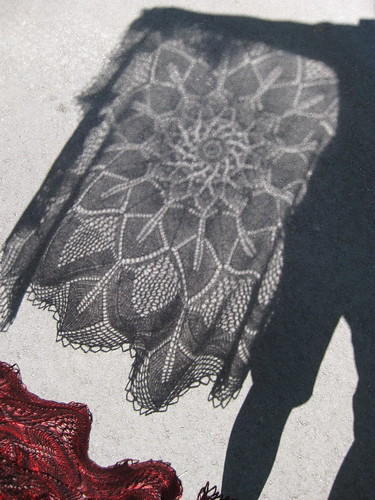



Recent Comments